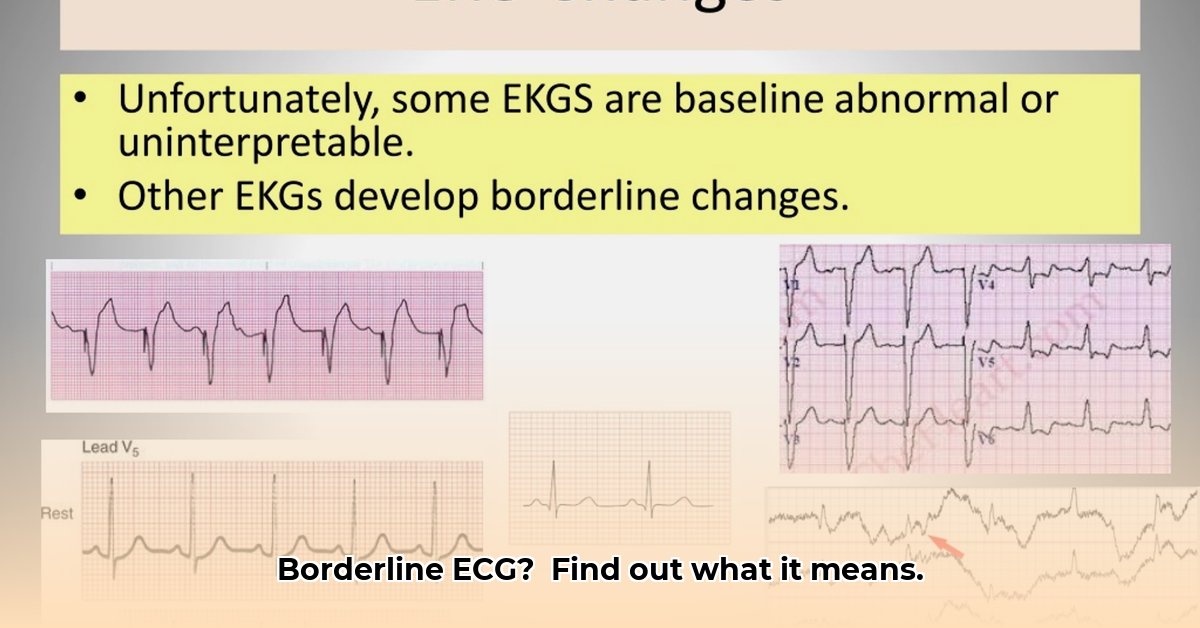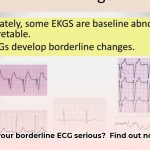Got a borderline ECG result and feeling a little freaked out? You’re not alone. A borderline ECG can be confusing, but it doesn’t automatically mean something’s seriously wrong. This guide will walk you through what a borderline ECG means, explain why your doctor might want more tests, and what you can expect next. We’ll keep it simple and straightforward, so you can understand your options and feel more confident about your heart health. Let’s get you the answers you need.
Borderline ECG and Further Testing: Understanding Your Results
LSI Keywords: electrocardiogram, heart health, cardiac testing
Getting a “borderline” ECG result can be unsettling. It’s like getting a slightly blurry photo – your heart’s rhythm shows some minor quirks, not quite “normal,” but not screaming “emergency” either. This doesn’t automatically mean something’s seriously wrong, but it does mean your doctor wants to take a closer look. Let’s break it down.
Decoding Your Borderline ECG: What Does It Mean?
LSI Keywords: ECG interpretation, heart rhythm, electrical activity
Imagine your heart’s electrical system as a super-efficient conductor leading an orchestra. The ECG (electrocardiogram) is a snapshot of this electrical activity, showing how your heart beats. A borderline ECG suggests a few minor “missed notes” – the rhythm isn’t perfectly smooth. These irregularities could be temporary, flaring up due to stress, not drinking enough water, electrolyte imbalances, or even certain medications. Or, they might point towards something needing further attention. It is often the case that a few minor abnormalities arise for a short span of time. That’s why more tests are often necessary to determine the underlying cause.
Do you wonder what factors contribute to these temporary irregularities in heart rhythm? Understanding these factors is the first step towards taking control of your heart health.
Why More Tests? It’s About Getting the Full Picture
LSI Keywords: diagnostic testing, heart condition, early detection
Your borderline ECG is like a puzzle piece – important, but not the whole picture. Further tests help complete the puzzle, giving your doctor a clearer picture of what’s going on with your heart. Ignoring a borderline result could mean missing a potential problem early on. Early detection increases your chances of successful treatment and preventing bigger problems down the road. The specific increase in successful treatment will vary based on the potential condition.
What Kinds of Tests Might Your Doctor Recommend?
LSI Keywords: stress test, echocardiogram, holter monitor
After a borderline ECG, your doctor might suggest several additional tests, depending on your specific situation and the ECG findings. These could include:
- Stress Test: This involves monitoring your heart while you exercise (usually on a treadmill or stationary bike). It shows how your heart handles increased demands. There are several types of stress tests, including exercise stress tests, nuclear stress tests, and stress echocardiograms.
- Echocardiogram (Echo): Think of this as an ultrasound for your heart. Sound waves create images of your heart’s structure and how well it’s pumping blood. There are different types of echos, including transthoracic echocardiograms (TTE), transesophageal echocardiograms (TEE), and stress echos.
- Holter Monitor: This is a small, portable ECG device you wear for 24-48 hours, or sometimes longer, constantly recording your heart’s rhythm. This helps catch those fleeting abnormalities that might not show up during a regular ECG. Event monitors are similar but worn for even longer periods, only recording when you trigger them due to symptoms.
- Blood Tests: These check for things like electrolyte imbalances (important for heart function), thyroid function, and other markers of heart health. Conditions like anemia can also impact heart function and be detected this way.
- Cardiac Catheterization: This is a more invasive procedure, generally reserved for situations where there’s serious concern about blood flow to the heart. A thin, flexible tube (catheter) is inserted into a blood vessel and guided to the heart. Dye is injected to visualize the arteries.
Your doctor will explain which tests are most appropriate for you and why, considering your symptoms, medical history, and the initial ECG findings.
Have you considered how lifestyle factors might play a role in your borderline ECG results? Exploring this can empower you to make positive changes.
Lifestyle Factors: Could They Be Playing a Role?
LSI Keywords: stress management, hydration, medication side effects
Sometimes, everyday habits can subtly influence your ECG. Are you constantly stressed, experiencing anxiety, or not getting adequate sleep? Do you sometimes neglect to drink enough water or consume excessive caffeine? Are you taking any medications, including over-the-counter drugs and supplements, that might affect your heart rhythm? These factors can temporarily mimic the irregularities seen in a borderline ECG. Making positive lifestyle changes might be enough to resolve the issue, or at least improve your overall heart health.
Consider that some medications, such as decongestants, can affect ECG readings. Always inform your doctor about all medications and supplements you are taking.
What You Can Do Now: Taking Control of Your Heart Health
LSI Keywords: proactive health, heart-healthy lifestyle, patient empowerment
Here’s how you can be proactive:
- Talk to Your Doctor: Don’t hesitate to discuss all your symptoms, even if they seem minor. Provide a complete picture of your health, including family history of heart disease.
- Follow Instructions: Adhere to all recommendations your doctor makes regarding further tests and lifestyle adjustments. Understand the purpose of each test and what the results might indicate.
- Manage Stress: Find healthy ways to cope with stress, like exercise, yoga, meditation, spending time in nature, or engaging in hobbies you enjoy. Consider professional counseling if stress feels overwhelming.
- Healthy Habits: Focus on a balanced diet rich in fruits, vegetables, and whole grains, regular exercise (at least 150 minutes of moderate-intensity or 75 minutes of vigorous-intensity aerobic activity per week), and avoiding smoking and excessive alcohol consumption. These are good for your overall health and your heart.
- Hydration is Key: Make sure you’re drinking plenty of water throughout the day. Dehydration can lead to electrolyte imbalances that affect heart rhythm.
- Monitor Your Blood Pressure: If you have high blood pressure, work with your doctor to manage it effectively through lifestyle changes or medication.
- Get Enough Sleep: Aim for 7-9 hours of quality sleep per night. Sleep deprivation can negatively impact heart health.
Remember, a borderline ECG and the subsequent tests are about gaining a better understanding of your heart health. It’s a proactive approach to ensuring your long-term well-being. Your doctor is your partner in this; work together to create a plan that puts your mind at ease and keeps your heart healthy.
Uncertainty and Ongoing Research: What We Don’t Yet Know
LSI Keywords: evolving research, ECG interpretation, heart health knowledge
While many cases of borderline ECGs are easily explained and resolved, it’s important to acknowledge that research into the implications of subtle ECG abnormalities is ongoing. Some experts are exploring new ways to interpret these findings, and our understanding of heart health is constantly evolving. This means that what we know today might be refined in the future. There is much we are still learning about the heart and how to interpret these complex readings. Your doctor will help you navigate this, and provide the best advice based on the current best available evidence, staying informed about the latest advancements in cardiology. Participating in clinical trials may also be an option in the future.
How to Interpret Borderline ECG Results and Next Steps
LSI Keywords: ECG results, follow-up care, medical advice
Key Takeaways:
- A borderline ECG doesn’t automatically mean serious heart disease, but it does require further investigation to determine the cause of the irregular findings.
- Several factors, from lifestyle choices to underlying conditions, can influence ECG readings. Addressing these factors can improve your overall health and potentially resolve the borderline ECG.
- Knowing what steps to take after receiving a borderline ECG is crucial for your peace of mind and heart health. Proactive engagement with your healthcare provider ensures that you receive tailored care and support.
Your doctor will guide you through the necessary next steps, tailored to your specific situation, considering your medical history, symptoms, and risk factors.
Understanding Borderline ECG Findings
LSI Keywords: electrocardiogram results, heart’s electrical activity, irregular heartbeats
Receiving a borderline ECG result can be unsettling. It means your electrocardiogram, a test that measures your heart’s electrical activity, shows some irregularities, but isn’t clearly indicative of a significant heart problem. Think of it as a yellow traffic light – not a full stop, but a signal to proceed cautiously. It necessitates further evaluation to understand what’s happening. These irregularities can manifest as slight deviations in the P wave, QRS complex, or T wave on the ECG tracing.
The interpretation of a borderline ECG is complex. Slight variations in the waveforms—the patterns your heart’s electrical signals create—can be influenced by many things. These factors include stress levels, anxiety, sleep quality, medication use, electrolyte imbalances (potassium, magnesium, calcium), hydration status, caffeine and alcohol consumption, and even body position during the test. Technical factors such as improper electrode placement or movement during the recording can also contribute to borderline results.
What to Do After a Borderline ECG
*LSI
- Wellness Fair Ideas for Work to Boost Employee Wellbeing - December 15, 2025
- Affordable Employee Wellness Fair Ideas for Any Budget - December 14, 2025
- Employee Wellness Programs Strategically Benefit Employee Health And Retention - December 13, 2025
















